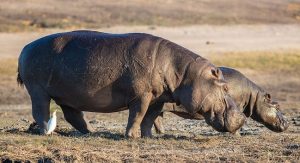In recognition of their unique place in the world and the challenges they face, World Hippo Day is celebrated every February 15 with the aim to raise awareness about the conservation needs of these magnificent animals. It serves as a reminder of our responsibility to protect them and their habitats, ensuring their survival for generations to come. In this article, Assaf Levy of BioDB explores the characteristics of hippos, their population and conservation status, their importance in nature, and the efforts being made to conserve them

The hippopotamus, often simply referred to as a hippo, is a creature that fascinates and delights those who are fortunate enough to witness it in its natural habitat. These semi-aquatic mammals, known for their massive bodies, wide-open mouths, and almost serene existence in the waters of sub-Saharan Africa, are not just wonders of nature’s design but also vital components of their ecosystems.
Hippos are the third-largest living land mammals after elephants and white rhinos. An adult male can weigh up to 3,200 kilogrammes (about 7,000 pounds), with females slightly smaller. Despite their bulk, hippos are surprisingly graceful in the water, where they spend most of their time.
Their specific gravity allows them to sink and walk or run along the bottom of rivers and lakes. Hippos are well adapted to their aquatic lifestyle, with eyes, ears, and nostrils located high on their heads, enabling them to breathe and look around while mostly submerged. Their large mouths, which can open up to 180 degrees, reveal large canines and incisors used primarily for defense.
A unique feature of hippos is their thick, hairless skin, which secretes a natural sunscreen, often referred to as “blood sweat,” to protect them from the sun’s harsh rays. This oily red secretion is not only a sunblock but also has antiseptic properties, helping to keep wounds clean and free from infection. This adaptation is crucial for their survival in the hot, sunny environments they inhabit.
Hippos are highly social animals, living in groups known as pods, bloats, or schools, which can consist of anywhere from 10 to 30 individuals, though larger groups of up to 100 hippos are not uncommon. These groups are typically made up of females with their young and a few non-breeding males, with a dominant male leading the group. The dominant male has exclusive breeding rights within the group, and his authority is established and maintained through displays of strength and aggression.
Additionally, hippos spend a significant amount of time in the water, where their social interactions occur. They communicate through grunts, bellows, and wheezes, a form of vocalization that plays a crucial role in the dynamics of the group. Despite their peaceful appearance, hippos can be quite aggressive, especially if they feel threatened. This aggression is most commonly observed between males fighting over territory or breeding rights.
Population Status
The hippopotamus is native to sub-Saharan Africa, dwelling in rivers, lakes, and mangrove swamps. Despite their broad distribution, hippos face numerous threats that have led to declining numbers. Habitat loss due to agriculture, human settlement, and industry is a significant factor. Additionally, hippos are poached for their meat and ivory (found in their teeth), further impacting their populations.
Currently, the International Union for Conservation of Nature (IUCN) lists the hippo as Vulnerable, with estimates suggesting there are between 115,000 and 130,000 individuals left in the wild. This classification underscores the pressing need for effective conservation measures to prevent their slide toward endangerment.
Acknowledging the critical role hippos play in their ecosystems and the various challenges threatening their existence, a collaborative effort among conservationists, governmental bodies, and non-governmental organisations (NGOs) has led to the launch of numerous initiatives aimed at safeguarding these splendid animals.
Among these efforts is the notable “Save the Hippos” campaign, which also marked the inception of World Hippo Day in 2016. This campaign, along with others, highlights the concerted actions taken to ensure the protection and preservation of hippos across their natural habitats.
Anti-poaching measures, such as increased patrolling of protected areas and the implementation of stricter laws against poaching and ivory trade, are critical components of these efforts. Additionally, habitat restoration projects seek to reclaim and protect natural habitats for hippos and other wildlife. Community-based conservation is another vital strategy, involving local communities in conservation efforts and providing them with sustainable alternatives to hunting and habitat encroachment. International cooperation is also essential, as the conservation of hippos requires cross-border efforts due to their habitat spanning multiple countries.
Conservationists are also employing innovative technologies to monitor hippo populations and their habitats. Satellite imagery, drone surveillance, and GPS tracking are tools that help gather data on hippo numbers, movements, and health, which is crucial for making informed conservation decisions.
The Way Forward
The survival of the hippopotamus is intricately linked to the health of Africa’s freshwater ecosystems and the communities that depend on them. As such, the conservation of hippos is not just about saving an iconic species; it’s about preserving the balance of ecosystems and the well-being of human populations as well.
The challenges are significant, but with continued effort, awareness, and international support, the future for hippos can be bright. It’s a testament to the resilience of nature and the power of collective action aimed at protecting our planet’s remarkable biodiversity.
In conclusion, the hippopotamus, with its unique physical characteristics, significant ecological role, and the challenges it faces, is a symbol of the broader issues of wildlife conservation and environmental stewardship. By understanding more about these gentle giants, we can appreciate their place in the natural world and the importance of efforts to ensure their survival.
Let’s hope that future generations will have the opportunity to marvel at these incredible animals, not just in pictures or documentaries, but thriving in their natural habitats, a lasting legacy of our commitment to conservation.
